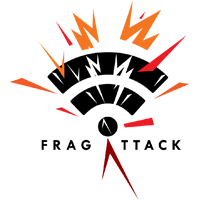- Jul 27, 2015
- 5,458
This is not a "hacking" tutorial but a demonstration about academic IT security research. Made by Mathy Vanhoef of New York University and KU Leuven. The tools shown are not public.
FragAttacks (fragmentation and aggregation attacks) which is a collection of new security vulnerabilities that affect Wi-Fi devices. An adversary that is within radio range of a victim can abuse these vulnerabilities to steal user information or attack devices. Three of the discovered vulnerabilities are design flaws in the Wi-Fi standard and therefore affect most devices. On top of this, several other vulnerabilities were discovered that are caused by widespread programming mistakes in Wi-Fi products. Experiments indicate that every Wi-Fi product is affected by at least one vulnerability and that most products are affected by several vulnerabilities.
The discovered vulnerabilities affect all modern security protocols of Wi-Fi, including the latest WPA3 specification. Even the original security protocol of Wi-Fi, called WEP, is affected. This means that several of the newly discovered design flaws have been part of Wi-Fi since its release in 1997! Fortunately, the design flaws are hard to abuse because doing so requires user interaction or is only possible when using uncommon network settings. As a result, in practice the biggest concern are the programming mistakes in Wi-Fi products since several of them are trivial to exploit.
To protect users, security updates were prepared during a 9-month-long coordinated disclosure that was supervised by the Wi-Fi Alliance and ICASI. If updates for your device are not yet available, you can mitigate some attacks (but not all) by assuring that websites use HTTPS and by assuring that your devices received all other available updates. The research will be presented at the USENIX Security conference and a longer talk with more background will also be given at Black Hat USA this summer.
The Wi-Fi flaws can also be abused to exfiltrate transmitted data. The demo shows how this can be abused to learn the username and password of the victim when they use the NYU website. However, when a website is configured with HSTS to always use HTTPS as an extra layer of security, which nowadays close to 20% of websites are, the transmitted data cannot be stolen. Additionally, several browsers now warn the user when HTTPS is not being used. Finally, although not always perfect, recent mobile apps by default use HTTPS and therefore also use this extra protection.
FragAttacks: Security flaws in all Wi-Fi devices
We present three security design flaws in Wi-Fi and widepread implementation flaws. These can be abused to exfiltrate user data and attack local devices.
The pre-recorded presentation made for USENIX Security can already be viewed online. Note that the target audience of this presentation are academics and IT professionals:
A tool was made that can test if clients or APs are affected by the discovered design and implementations flaws. It can test home networks and enterprise networks where authentication is done using, e.g., PEAP-MSCHAPv2 or EAP-TLS. The tool supports over 45 test cases and requires modified drivers in order to reliable test for the discovered vulnerabilities. Without modified drivers, one may wrongly conclude that a device is not affected while in reality it is.
A live USB image is also available. This image contains pre-installed modified drivers, modified firmware for certain Atheros USB dongles, and a pre-configured Python environment for the tool. Using a live image is useful when you cannot install the modified drivers natively (and using a virtual machine can be unreliable for some network cards).
Q&A
Will using a VPN prevent attacks?
Using a VPN can prevent attacks where an adversary is trying to exfiltrate data. It will not prevent an adversary from bypassing your router's NAT/firewall to directly attack devices.

/i/1396344911.png?f=meta)
